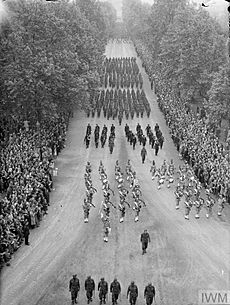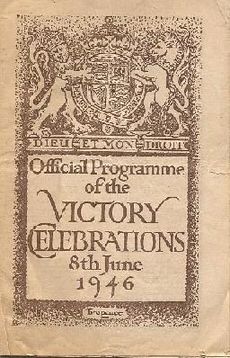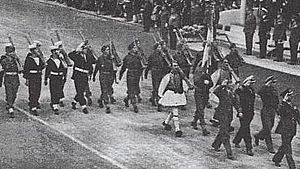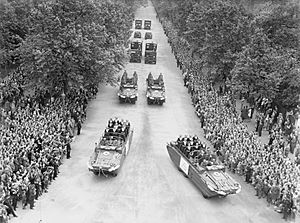London Victory Celebrations of 1946 facts for kids
The London Victory Celebrations of 1946 were big parties held in London to celebrate the end of World War II. This was after Nazi Germany and Japan were defeated. These celebrations took place on 8 June 1946. They mostly included a huge military parade through the city and a fantastic fireworks show at night. Many countries that were allies with Britain joined in the parade. These included Belgium, Brazil, China, France, Greece, the Netherlands, and the United States.
Contents
The Big Victory Parade

The parade was a huge event! It started with important military leaders. These were the British Chiefs of Staff and other top Allied commanders.
Next came a long line of vehicles. This part of the parade was called the "mechanised column." It was over four miles long! More than 500 vehicles were in it. These vehicles came from the Royal Navy, the Royal Air Force, and the British Army. Even British civilian services had vehicles in the parade.
After the vehicles, a marching column followed. This part of the parade began with the flags of all the Allied nations. Each flag had its own special guard. Then came soldiers, sailors, and air force members. They were from the British Empire and the Commonwealth Dominions. The Royal Navy, British civilian services, and the British Army also marched. Representatives from Allied air forces and the Royal Air Force were there too.
The parade ended with an amazing fly-past. About 300 aircraft flew over London. The famous pilot Douglas Bader led this impressive display.
Most of the Allied countries sent people to the parade. This included the US, France, Belgium, Brazil, Czechoslovakia, Denmark, Egypt, Greece, and the Netherlands. However, a few Allied countries were not represented. These were the USSR, Yugoslavia, and Poland.
Australia's Part in the Parade
Australia sent a group of 250 servicemen and women. They were from the army, navy, and air force. Their leader was Major General Ken Eather. He was a very brave officer during the war. One special person in the group was Private Richard Kelliher. He had won the Victoria Cross, which is a very high award for bravery. The Australian group traveled to the United Kingdom on a ship called HMAS Shropshire. They left on 8 April 1946.
New Zealand's Part in the Parade
New Zealand also sent a group to the victory march. There were 300 people in their group. They were former and serving members of the armed forces. The group included 150 from the army, 100 from the Royal New Zealand Air Force, and 50 from the Royal New Zealand Navy. Women were part of all three sections. There were also members of the Maori Battalion.
Lieutenant-General Sir Edward Puttick led the New Zealand group. He was in charge of the New Zealand Forces during the war. The group also included several brave soldiers who had won the Victoria Cross. These were Colonel Leslie Andrew, Sergeant Alfred Clive Hulme, and Charles Upham. The New Zealand group sailed from New Zealand on 20 April. They traveled on a hospital ship called Maunganui.
Nighttime Fun
After the sun went down, London's main buildings lit up. Bright floodlights made them shine. Crowds gathered along the Thames and on Westminster Bridge. They watched King George VI and his family. The Royal family went down the river in their special boat, the Royal barge.
The planned celebrations ended with a huge fireworks show. The fireworks lit up the sky over Central London. Even after the Royal family went home, people stayed in London. Many gathered around Buckingham Palace. Some people couldn't get home that night. They spent the rest of the night in public parks and other areas around London.
Special Events for Kids
There were also fun activities for children. These events took place in London's parks. King George VI sent a special message to children. This message was printed on cards. It was given to school children all over the United Kingdom. The message started with the words 'Today, as we celebrate victory'.
See also
- Berlin Victory Parade of 1945




